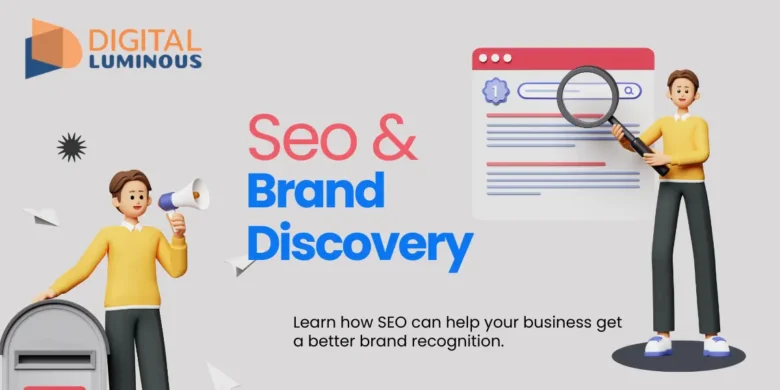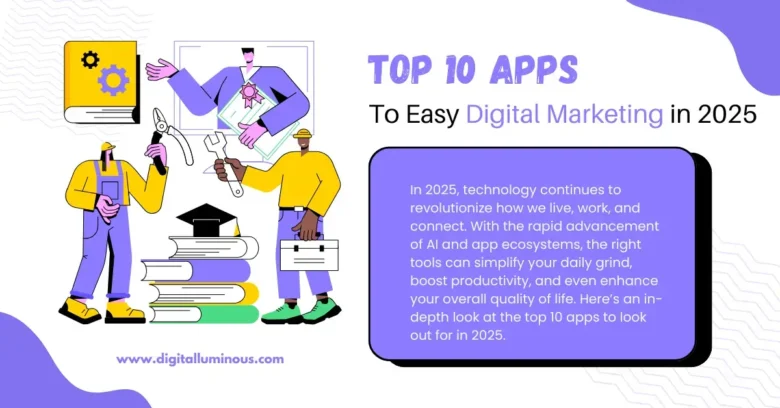
Are you curious about email marketing and how it can supercharge your business or marketing efforts? Well, you’re in the right place!
In this guide, we’ll deep dive into the world of email marketing, exploring its definition, historical journey, core elements, benefits, best practices, and common mistakes.
So, grab a cup of coffee, sit back, and with us let’s start interesting journey of email marketing!
What is Email Marketing and Why Does it Matter?
Email marketing is a powerful digital marketing strategy that involves sending emails to prospects and customers with the aim of promoting products or services, nurturing leads, building relationships, and driving conversions.
It’s not just about sending random emails; it’s about crafting targeted and personalized messages that resonate with your audience.
In today’s digital age, where almost everyone has an email address, email marketing remains one of the most effective ways to reach and engage your target audience.
Whether you’re a small local business or a multinational corporation, email marketing can help you connect with your customers on a personal level and drive meaningful results for your business.
Example: Imagine you run a family-owned bakery in New York City. By sending out weekly newsletters showcasing your latest pastry creations, special promotions, and upcoming events, you can keep your loyal customers informed and engaged, ultimately driving foot traffic to your bakery and increasing sale.
The Evolution of Email Marketing: From Humble Beginnings to Modern-Day Powerhouse
The journey of email marketing dates back to the early days of the internet when businesses first started exploring the potential of electronic mail as a marketing tool.
Back then, email marketing was simple and straightforward, with marketers sending basic text-based emails to their subscribers.
However, as technology advanced and consumer behavior evolved, so did email marketing. Today, we have sophisticated email marketing platforms that offer a myriad of features and capabilities, such as automation, personalization, segmentation, and analytics.
These advancements have transformed email marketing into a highly targeted and data-driven strategy that delivers impressive results.
Example: The iconic American brand, Coca-Cola. In the late 1990s, Coca-Cola launched one of the first-ever email marketing campaigns, inviting subscribers to join their "Coke Red Lounge" and receive exclusive content and promotions. This pioneering campaign laid the groundwork for the future of email marketing, demonstrating its potential to engage and delight consumers.
The Core Elements of Email Marketing: Building Blocks for Success
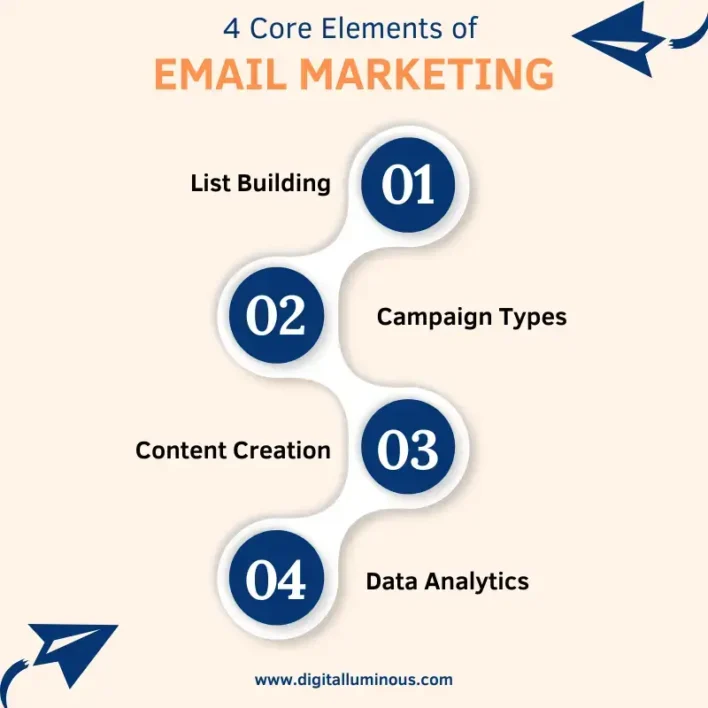
List Building
Building a quality email list is the foundation of any successful email marketing campaign. Your email list is made up of individuals who have willingly opted in to receive emails from you, making them highly valuable leads.
There are various strategies for list building, including offering lead magnets such as ebooks, webinars, or exclusive discounts, and optimizing your website and social media channels for email sign-ups.
Example: Imagine you're a boutique clothing store owner in Los Angeles. To build your email list, you host a fashion show event showcasing the latest trends and designs from local designers. Attendees can sign up for your email list at the event to receive exclusive discounts and updates on new arrivals. By targeting fashion-forward consumers in the heart of LA, you quickly grow your email list with engaged subscribers eager to stay connected with your brand.
Campaign Types
Email marketing campaigns come in various forms, each serving a specific purpose in your overall marketing strategy. Some common types of email campaigns include:
- Newsletter: A regular update sent to subscribers with news, updates, and valuable content.
- Promotional Emails: Emails designed to promote specific products, services, or offers.
- Drip Campaigns: Automated series of emails sent to nurture leads or guide customers through a sales funnel.
- Transactional Emails: Automated emails triggered by specific actions, such as purchases or account sign-ups.
Example: Let's say you run an e-commerce store selling handmade jewelry. To promote your latest collection, you send out a series of promotional emails featuring stunning product images, customer testimonials, and limited-time offers. These emails not only showcase your products but also create a sense of urgency, driving sales and engagement among your subscribers.
Content Creation
Content is king in email marketing. The success of your email campaigns depends largely on the quality and relevance of your content.
Whether it’s informative blog posts, captivating images, or compelling calls-to-action (CTAs), your content should resonate with your audience and inspire them to take action.
Example: Suppose you're a travel blogger based in Los Angeles. To engage your subscribers and inspire them to explore new destinations, you send out a monthly newsletter featuring stunning travel photography, insider tips, and exclusive travel deals. By sharing your own experiences and expertise, you establish yourself as a trusted authority in the travel niche and drive traffic to your blog and affiliate partners.
Analytics
Analytics play a crucial role in email marketing, helping you track the performance of your campaigns and make data-driven decisions to optimize your results. Key metrics to monitor include open rates, click-through rates, conversion rates, and unsubscribe rates.
Example: As a digital marketer in Chicago, you regularly analyze the performance of your email campaigns to gauge their effectiveness and identify areas for improvement. By closely monitoring metrics such as open rates and click-through rates, you gain valuable insights into what resonates with your audience and adjust your strategies accordingly. For example, you notice that emails with personalized subject lines have higher open rates, so you decide to incorporate more personalization into your future campaigns to boost engagement.
The Benefits of Email Marketing: Why It Pays to Get It Right
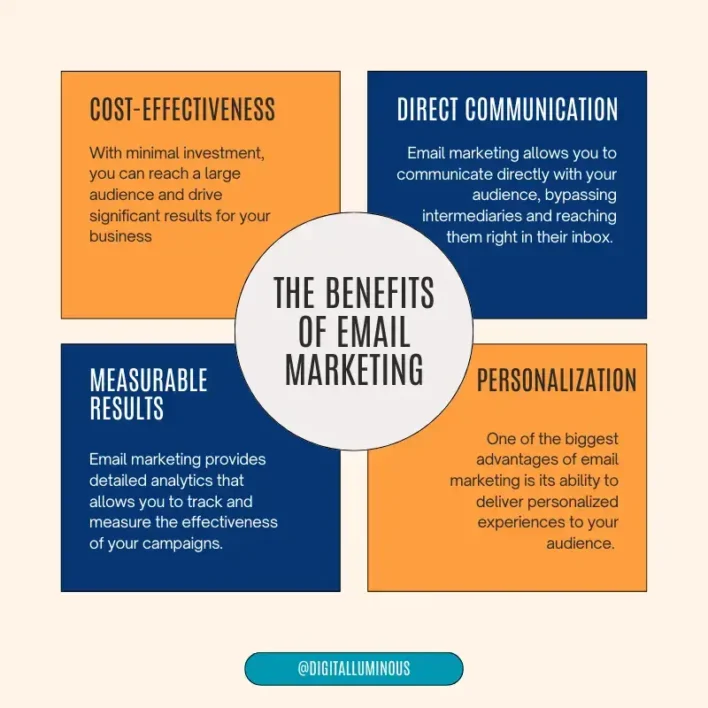
Cost-Effectiveness:
Unlike traditional forms of advertising such as print or TV ads, email marketing is incredibly cost-effective. With minimal investment, you can reach a large audience and drive significant results for your business.
Direct Communication:
Email marketing allows you to communicate directly with your audience, bypassing intermediaries and reaching them right in their inbox. This direct line of communication gives you the opportunity to deliver personalized messages tailored to each recipient’s interests and preferences.
Personalization:
One of the biggest advantages of email marketing is its ability to deliver personalized experiences to your audience. By segmenting your email list and tailoring your content to each segment’s preferences, you can increase engagement and conversions significantly.
Measurable Results:
Email marketing provides detailed analytics that allows you to track and measure the effectiveness of your campaigns. You can monitor open rates, click-through rates, conversion rates, and more, enabling you to assess what works and what doesn’t. This data-driven approach helps you refine your strategies for better performance and higher returns on investment.
Best Practices to Boost your Email champaign efforts
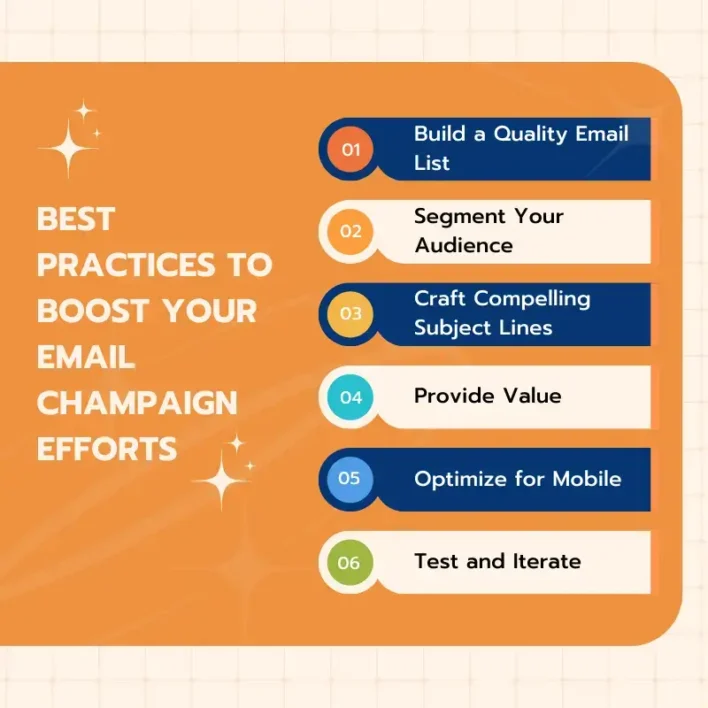
Build a Quality Email List:
Focus on growing your email list organically and avoid purchasing or renting email lists, which can harm your deliverability and reputation.
Segment Your Audience:
Divide your email list into smaller segments based on demographics, interests, or purchase history to deliver more targeted and relevant content.
Craft Compelling Subject Lines:
Grab your subscribers’ attention with clear, concise, and enticing subject lines that encourage them to open your emails.
Provide Value:
Offer valuable content, exclusive offers, or insider tips that resonate with your
Optimize for Mobile:
With the majority of emails being opened on mobile devices, ensure that your emails are mobile-friendly and render properly on smartphones and tablets.
Test and Iterate:
Continuously test different elements of your email campaigns, such as subject lines, content, and CTAs, and use A/B testing to identify what resonates best with your audience.
Monitor Analytics:
Regularly analyze key metrics to track the performance of your email campaigns and make data-driven decisions to optimize your results.
Common mistakes to avoid for your Email Marketing Boost
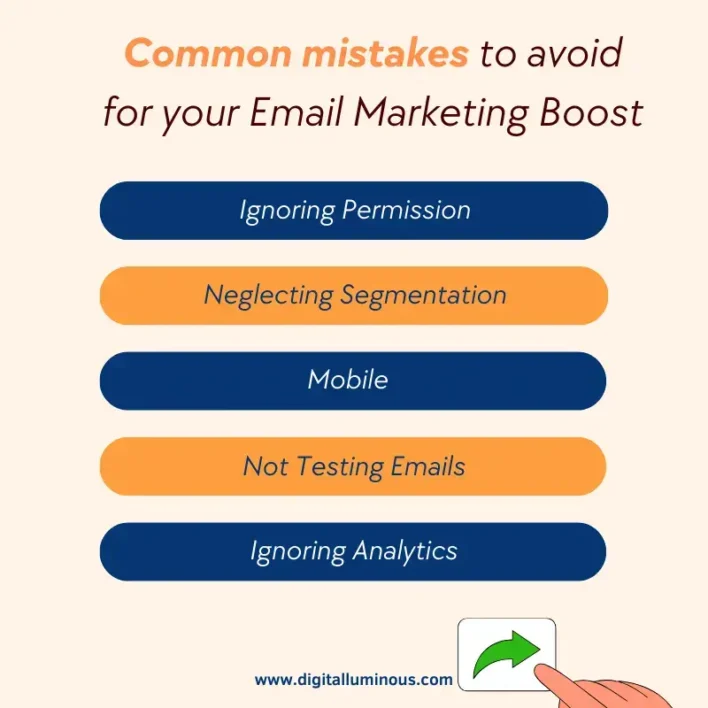
Ignoring Permission:
Sending emails to recipients who haven’t opted in or unsubscribed from your list can damage your reputation and lead to spam complaints.
Neglecting Segmentation:
Sending generic, one-size-fits-all emails to your entire list can result in low engagement and high unsubscribe rates.
Overlooking Mobile Optimization:
Failing to optimize your emails for mobile devices can result in poor user experience and lost opportunities for engagement.
Not Testing Emails:
Neglecting to test your emails across different devices and email clients can lead to formatting issues and poor deliverability.
Ignoring Analytics:
Failing to track and analyze key metrics can prevent you from understanding what’s working and what’s not, making it difficult to improve your campaigns over time.
Conclusion
In conclusion, email marketing is a powerful tool that can help businesses of all sizes connect with their audience, drive engagement, and achieve their marketing goals.
By understanding the core elements of email marketing, harnessing its benefits, and following best practices while avoiding common mistakes, you can unlock the full potential of this versatile marketing strategy.
Remember, email marketing is not just about sending emails; it’s about building relationships, providing value, and delivering personalized experiences that resonate with your audience.
So, whether you’re a small local business or a multinational corporation, email marketing can be the key to unlocking success in today’s digital world.
Now that you have a solid understanding of email marketing, it’s time to roll up your sleeves and start crafting your own email campaigns that captivate, engage, and convert your audience. Happy emailing!
FAQs
What is email marketing?
Email marketing is a digital marketing strategy that involves sending emails to prospects and customers to promote products or services, share news and updates, and build relationships with the audience.
Why is email marketing important today?
Email marketing allows businesses to connect directly with their audience, deliver personalized messages, and drive engagement and conversions.
How does email marketing work?
Businesses collect email addresses from subscribers who opt-in to receive emails. They then create and send targeted email campaigns using an email marketing platform.
Is email marketing still effective in 2025?
Yes, email marketing remains a highly effective marketing channel, with high ROI and engagement rates, especially when used strategically.
What types of emails can businesses send?
Businesses can send various types of emails, including newsletters, promotional emails, transactional emails, and automated drip campaigns.
How can businesses build an email list?
Businesses can build an email list by offering incentives such as discounts or exclusive content, hosting events, or using lead generation forms on their website.
What is segmentation in email marketing?
Segmentation involves dividing an email list into smaller segments based on demographics, interests, or behavior to send more targeted and relevant content.
What are the key metrics to track in email marketing?
Key metrics include open rates, click-through rates, conversion rates, bounce rates, and unsubscribe rates.
How can businesses improve their email deliverability?
Businesses can improve deliverability by maintaining a clean email list, sending relevant content, avoiding spam triggers, and following best practices.
How can businesses create engaging email content?
Businesses can create engaging content by providing value, using compelling visuals, incorporating storytelling, and personalizing content to the recipient.
How can businesses measure the success of their email campaigns?
Businesses can measure success by tracking key metrics such as open rates, click-through rates, conversion rates, and ROI, and comparing results against benchmarks and goals.
What are some common mistakes to avoid in email marketing?
Common mistakes include sending too many emails, neglecting list hygiene, using misleading subject lines, and failing to optimize emails for mobile devices.
What is A/B testing in email marketing?
A/B testing involves sending two versions of an email to a small segment of the audience to test different elements such as subject lines, content, or CTAs, and determining which performs better.
